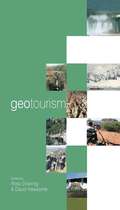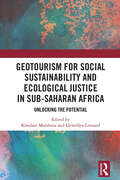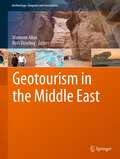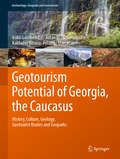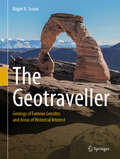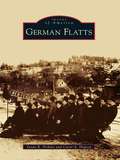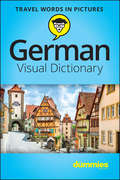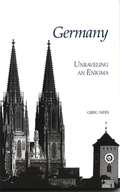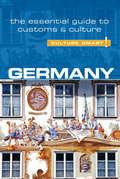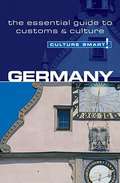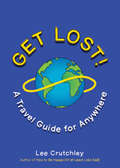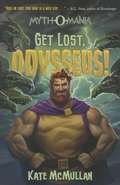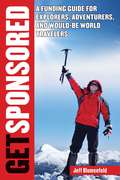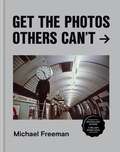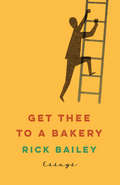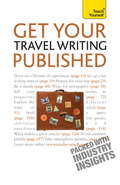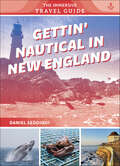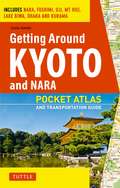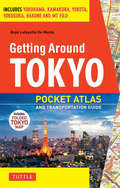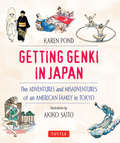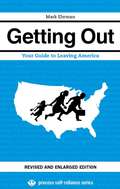- Table View
- List View
Geotourism
by David Newsome Ross DowlingGeotourism is tourism surroounding geological attractions and destinations. This unique text uses a wealth of case studies to discuss the issues involved in the management and care of such attractions, covering topics such as sustainability, impacts and environmental issues. Geotourism: Sustainability, impacts and management leads the reader logically through the process, covering both the theories involved and the practicalities of managing such 'environmentally precious' attractions.
GeoTourism for Social Sustainability and Ecological Justice in Sub-Saharan Africa: Unlocking the Potential
by Khodani Matshusa Llewellyn LeonardThis book provides a comprehensive overview of the potential of geotourism in sub-Saharan Africa for promoting social sustainability and ecological justice. It examines the challenges facing the region for geotourism development and the innovative approaches and best practices for overcoming these.Drawing on case studies from the region, the book provides innovative insights that explore the intersection of geotourism with poverty alleviation and job creation. Thematically it engages with a range of critical issues, from leveraging geotourism for local socio-economic development to the intersection of geotourism with environmental conservation efforts. The book delves into the intricacies of geoheritage and geotourism threats in the face of climate change and extractive industries. By examining the untapped potential of geoheritage sites, this book seeks to shed light on opportunities for promoting local sustainable development in economic, social, and environmental dimensions.The book will be of great interest to academic scholars, including undergraduate and postgraduate students, industry, governments, and tourism and conservation organisations. It will be of appeal to individuals in the fields of geotourism, ecotourism, cultural tourism, sustainable tourism development, geoeducation, and geoscience.
Geotourism in the Middle East (Geoheritage, Geoparks and Geotourism)
by Mamoon Allan Ross DowlingThe geotourism industry has grown rapidly in recent years. This book introduces the geotourism industry, its attractions, activities and developments, in selected countries of the Middle East. A number of publications and studies have investigated the nature and scope of the phenomenon of geotourism (tourism which starts from geology) and geotourists worldwide. However, despite the breadth of these studies, few publications have investigated the phenomena in the Middle Eastern countries.Consequently, this book seeks to shed light on the different aspects of geotourism and geo-diversity in the Middle East and provides a number of case studies from this region. It assists in bridging the lacuna in the tourism and geology literature and helps planners, marketers, managers, scholars and researchers to enhance their knowledge about such issues. It outlines opportunities for, as well as barriers to, geotourism development in the Middle East as well as providing recommendations for the advancement of geotourism in the region.
Geotourism Potential of Georgia, the Caucasus: History, Culture, Geology, Geotourist Routes and Geoparks (Geoheritage, Geoparks and Geotourism)
by Irakli Gamkrelidze Avtandil Okrostsvaridze Kakhaber Koiava Ferando MaisadzeGeorgia’s territory represents a real “natural geological laboratory,” exposing magmatic, metamorphic and sedimentary rocks, ranging from the Neoproterozoic to the Quaternary. After a brief presentation of Georgia’s history and culture, the authors present the stratigraphy, rock types of individual tectonic zones of Georgia, their tectonic structure and paleotectonic reconstructions of the Caucasus.This book describes the three main geotourism routes of Georgia meticulously: 1. Tbilisi-Pasanauri-Kazbegi (along the Georgian Military Road), 2. Tbilisi-Zugdidi-Mestia-Ushguli and 3. Tbilisi-Khashuri-Vardzia, which cross different parts of Fold Systems of the Greater and Lesser Caucasus and Transcaucasian Intermountain area.The following potential geoparks are described in this book: 1. Sataplia dinosaur footprints together with Sataplia and Prometheus caves; 2. Tskaltubo resort-town and mineral water deposit; 3. Borjomi resort-town and mineral water deposit; 4. Kazbegi Quaternary volcanoes and Keli volcanic highland;5. Dariali Paleozoic granitoid massif; 6. Dmanisi hominids site and the Mashavera gorge basaltic flow; 7. Dashbashi canyon; 8.Uplistsikhe rock-cut town and Kvakhvreli cave complex; 9.Udabno - Upper Miocene marine and continental deposits and David Gareja monastery complex;10. Dedoplistskaro - Vashlovani protected areas and mud volcanoes.
The Geotraveller: Geology of Famous Geosites and Areas of Historical Interest
by Roger N. ScoonThis book describes famous geosites and historical localities in national parks and conservation areas from North America, East Africa, and Europe. The geosites include iconic landforms associated with active volcanoes, canyons, glaciated landscapes, natural rock monoliths, and rifts. The potential for geotourism in historical localities such as the famous Greco-Roman antiquities of Greece, Italy, and Turkey, is emphasised.Some of the geosites and historical localities provide evidence that previous civilizations coped with active geology and major climatic cycles, whilst others reveal evidence of famous geological events recognized in history and ancient mythology that helped shape our current civilization.The book assists tour guides and visitors (both geologists and non-specialists) interested in geotourism by providing an understanding of geological processes in the national parks and historical locations with the assistance of photographs and simplified geological maps.
German Flatts
by Caryl A. Hopson Susan R. PerkinsGerman Flatts was established on March 7, 1788, and is comprised of two unique villages. The village of Mohawk was incorporated in 1844, and Ilion soon followed in 1852. With their proximity to the Erie Canal, these villages saw their share of business and industry and flourished as communities. Mohawk was home to a number of famous people, including a treasurer of the United States, a General Motors industrialist, one of the fated space shuttle Challenger crew members, and the two Keno brothers who made antiques a popular obsession on the television program Antiques Roadshow. Ilion is the birthplace of the Remington Arms Company, one of Herkimer County's oldest industries that still exists today and is known around the world. German Flatts provides an interesting snapshot of the daily life and important events in this community's fascinating history.
German Visual Dictionary For Dummies
by Consumer DummiesGerman Visual Dictionary A visual way to learn GermanIt’s a fact—seeing something helps us remember it. This handy guide helps you build your German vocabulary with full-color pictures that illustrate the words. You’ll be able to communicate with native speakers faster as you learn and remember more words and their meanings. The book is organized by themes such as transportation, accommodations, restaurants and eating, sports, emergencies, shopping, and more, making it especially useful for travelers. Boost your learning speed today!InsideNavigate a cityHandle money like a localMaster short conversationsBe prepared for emergencies
Germany: Unraveling An Enigma (Interact Ser.)
by Greg NeesSo we think we know a lot about Germans? After all, more Germans have immigrated to the United States than any other ethnic group, and fifty million American citizens currently claim German heritage. The truth is though, Germans are different from us in more ways than we may know. Greg Nees, in this new title in the InterAct sseries, Germany: Unraveling an Enigma, does an outstanding job of explaining those cultural differences that we most need to know in order to have effective and fulfilling interactions with the Germans. Nees explores major German cultural themes: the need for order and obedience to rules and regulations, the insistence on clarity of thought, compartmentalization, the penchant for rational thinking and the love of abstract debate, the sharp distinction between insiders and outsiders, a strong sense of duty, and German communication patterns. As a business consultant who has lived and worked many years with Germans, Greg Nees gives special attention to the German social market economy and to cultural differences in the workplace. Perhaps most valuable, in his last chapter he looks to the future as Germany seeks to create a new identity in the twenty-first century, dealing with such issues as multiculturalism, Americanization, changing lifestyles, the European Union, and globalization.
Germany - Culture Smart!
by Barry TomalinWith the FIFA World Cup in its pocket Germany is feeling its social, political, and economic power once again. After organizing a successful World Cup in 2006 and winning it against Argentina in Brazil in 2014, Germany sees a note of confidence, even triumphalism, permeating the country. As a European leader committed to the success of the EU and the Eurozone, Germany is a leading driver of European affairs. It emerged from the recession of 2008 as the strongest economic power in Europe, and German manufacturing, product brand value, and exports are going from strength to strength. What are the implications of this new world confidence for German society itself? In the last few years we have seen East and West Germany come together socially and achieve a greater degree of economic balance as a long-term result of German re-unification. At the same time German society itself is internationalizing, with increased immigration and the adaptation of age-old values and attitudes to a multinational, multicultural era. Traditional attitudes of formality and rigid protocol in business are softening as German business globalizes. This new, updated edition of Culture Smart! Germany examines these changes. It explains how German traditional values and working methods are adapting to take advantage of international opportunities and global society while maintaining the commitment to quality, organization, and time that marks out German business life. It shows how the traditional differences between Germany's regions are lessening, enabling society to come together and better absorb new immigrants, and above all how Germans are losing the fear and guilt associated with their twentieth-century wars and finding a new voice on the international stage.
Germany - Culture Smart!
by Barry TomalinCulture Smart! provides essential information on attitudes, beliefs and behavior in different countries, ensuring that you arrive at your destination aware of basic manners, common courtesies, and sensitive issues. These concise guides tell you what to expect, how to behave, and how to establish a rapport with your hosts. This inside knowledge will enable you to steer clear of embarrassing gaffes and mistakes, feel confident in unfamiliar situations, and develop trust, friendships, and successful business relationships.Culture Smart! offers illuminating insights into the culture and society of a particular country. It will help you to turn your visit-whether on business or for pleasure-into a memorable and enriching experience. Contents include* customs, values, and traditions* historical, religious, and political background* life at home* leisure, social, and cultural life* eating and drinking* do's, don'ts, and taboos* business practices* communication, spoken and unspoken"Culture Smart has come to the rescue of hapless travellers." Sunday Times Travel"... the perfect introduction to the weird, wonderful and downright odd quirks and customs of various countries." Global Travel"...full of fascinating-as well as common-sense-tips to help you avoid embarrassing faux pas." Observer"...as useful as they are entertaining." Easyjet Magazine"...offer glimpses into the psyche of a faraway world." New York Times
Get Lost!: A Travel Guide for Anywhere
by Lee CrutchleyA wildly different adventure guide: Follow the prompts to see, feel, and learn something new wherever you go--in a new city or even your own hometownForget old-fashioned travel books with cookie-cutter advice on where to go and what to do. With this hip, ingenious and creative companion, you'll have a unique and surprising experience anywhere you go.Feeling lost? Lonely? In need of a snack? Flip to the designated page and follow the directions for an adventure, taking you off the beaten path and on a journey of discovery that's different every time.From the wandering mind and colorful sketchbook of Lee Crutchley, author of How to Be Happy (or at Least Less Sad), this delightful full-color book will give even the most jaded traveler a fresh experience--and a fun way to rediscover the joy of exploring the world around us, and even ourselves.
Get Lost, Odysseus!
by Kate Mcmullan Kevin KeeleThe Trojan War is over, but now Odysseus has to find his way home to Ithaca . . . and in typical fashion, he's angered Poseidon enough that the sea-god has decided to make his journey miserable (if not impossible). But Hades has a soft spot for the long-gone warrior, so even if he's sworn to Poseidon he won't help Odysseus directly, he might be able to pull a few strings . . .
GET PAID TO TRAVEL: COME VIAGGIARE GRATIS CON IL TIMESHARE
by Filippo Iuliani Travel HackerzUn semplice libro per cambiare il business del timeshare a nostro vantaggio. Per decenni il business legato al timeshare si è rivelato dannoso per le persone. E' arrivata ora di prenderne atto e capire come cambiarlo a nostro favore. Questa guida informativa vi insegnerà i secreti, le strategie che i venditori utilizzano per guadagnare sulle tasche di una coppia di lavoratori ma soprattutto come non farsi raggirare e rendere questo a nostro favore e cominciando a guadagnare. In questo libro Come alloggiare gratis in un resort di lusso a cinque stelle Come venire pagati 100$ all'ora mentre siete in vacanza Come evitare di spendere decina di migliaia di dollari in ridicoli timeshare. Come fare delle romantiche gite in battello Come fare delle crociere gratis tutto incluso per tre giorni. Come ricevere lettere che riguardino nuove vacanza qualche volta l'anno senza muovere un dito. Questo libro vi farà risparmiare decina di migliaia di dollari per costi di viaggio inutili, e sarà utile per chiunque voglia mettere per la prima volta i propri piedi in un resort a cinque stelle in qualsiasi parte del mondo. Comprando questo libro scoprirete come viaggiare come una rockstare completamente gratis.
Get Sponsored: A Funding Guide for Explorers, Adventurers, and Would-Be World Travelers
by Jeff BlumenfeldChristopher Columbus needed a sponsor for a dangerous expedition, but the king of Portugal wasn't interested. He repackaged his proposal for the queen of Spain. She put Columbus on retainer, and the rest is history. Columbus may not have been the first to discover America, but he had a great publicist.That's where Jeff Blumenfeld comes in. For many years, using a PR specialty called adventure marketing, Jeff has connected explorers and their projects with corporate sponsors looking to demonstrate product performance in extreme conditions. His book takes the reader from Erik Weihenmayer's expedition to be the first blind man to summit Mount Everest, to the first confirmed dogsled expedition of the North Pole, to Audrey Mestre's deadly free dive expedition off Bayahibe beach in the Dominican Republic. You Want to Go Where? is the only book that not only takes you behind the scenes of some of the most dangerous adventure expeditions in recent years, but also shows how you can fund and arrange your own trip, including details on everything from grants to sponsorships.For anyone who's ever had a dream to scale the tallest mountain or cross the largest ocean, You Want to Go Where? is your ticket. Full of fascinating stories and practical advice, it's ideal for armchair explorers and budding adventurers alike.
Get the Photos Others Can't
by Michael FreemanGetting the best possible photo is not a game of chance - there are proven methods and innovative approaches that the professional photographer uses to succeed. From Freeman's decades of reportage experience, he has developed proven methods for going beyond where tourists stop, and delivering the photographs that make the cover. Get the Photos Others Can't uses five 'nodes' or guiding principles, in various combinations, to elucidate each particular method of access: Right Place, Right Time - train yourself in the art of anticipationHearts & Minds - understand the importance of people skillsImmersion - involve yourself fully in your subjectDeep Learning - research and reflect Left Field - take an unexpected direction to find a new angle.With examples from Freeman's own archive of images, as well as from iconic photographers including Weegee, Cindy Sherman, Guy Bourdin, W. Eugene Smith and Garry Winogrand, the secrets shared in this book will let you find your own modus operandi for overcoming the obstacles between you and the shot, so you can bring home your own world-class images.
Get the Photos Others Can't
by Michael FreemanGetting the best possible photo is not a game of chance - there are proven methods and innovative approaches that the professional photographer uses to succeed. From Freeman's decades of reportage experience, he has developed proven methods for going beyond where tourists stop, and delivering the photographs that make the cover. Get the Photos Others Can't uses five 'nodes' or guiding principles, in various combinations, to elucidate each particular method of access: Right Place, Right Time - train yourself in the art of anticipationHearts & Minds - understand the importance of people skillsImmersion - involve yourself fully in your subjectDeep Learning - research and reflect Left Field - take an unexpected direction to find a new angle.With examples from Freeman's own archive of images, as well as from iconic photographers including Weegee, Cindy Sherman, Guy Bourdin, W. Eugene Smith and Garry Winogrand, the secrets shared in this book will let you find your own modus operandi for overcoming the obstacles between you and the shot, so you can bring home your own world-class images.
Get Thee to a Bakery: Essays
by Rick BaileyGet Thee to a Bakery is a collection of short, tart essays that explore both humorous and harrowing aspects of growing older and making sense of social, technological, and environmental change. Topics range from earworms and industrial eggs to peaches and personal data, from bug die-offs to algae blooms and global warming, and from beards and yoga to the irrepressible American smile. Many of these essays make discursive moves into science and literature, framing issues and conflicts that resonate in contemporary American life. With a conversational style, distinctive voice, and great comic timing, Bailey entertains and surprises.
Get Your Travel Writing Published: Teach Yourself (TY Creative Writing)
by Cynthia DialGet Your Travel Writing Published will give those of you who love to travel and long to write about it the essential tools to turn it into a profession. By the end of this book, you will know what steps you will need to take to get your work published, the ABCs of writing winning travel articles and the markets available to you, all while avoiding common beginner's pitfalls. NOT GOT MUCH TIME? One, five and ten-minute introductions to key principles to get you started. AUTHOR INSIGHTS Lots of instant help with common problems and quick tips for success, based on the author's many years of experience. TEST YOURSELF Tests in the book and online to keep track of your progress. EXTEND YOUR KNOWLEDGE Extra online articles at www.teachyourself.com to give you a richer understanding of getting your travel writing published. FIVE THINGS TO REMEMBER Quick refreshers to help you remember the key facts. TRY THIS Innovative exercises illustrate what you've learnt and how to use it.
Get Your Travel Writing Published: Perfect your travel writing and share it with the world (Teach Yourself Creative Writing Ser.)
by Cynthia DialGet Your Travel Writing Published will give those of you who love to travel and long to write about it the essential tools to turn it into a profession. By the end of this book, you will know what steps you will need to take to get your work published, the ABCs of writing winning travel articles and the markets available to you, all while avoiding common beginner's pitfalls.NOT GOT MUCH TIME?One, five and ten-minute introductions to key principles to get you started.AUTHOR INSIGHTSLots of instant help with common problems and quick tips for success, based on the author's many years of experience.TEST YOURSELFTests in the book and online to keep track of your progress.EXTEND YOUR KNOWLEDGEExtra online articles at www.teachyourself.com to give you a richer understanding of getting your travel writing published.FIVE THINGS TO REMEMBERQuick refreshers to help you remember the key facts.TRY THISInnovative exercises illustrate what you've learnt and how to use it.
Gettin' Nautical in New England
by Daniel SeddiquiIn the latest edition of the Immersive Travel Guide series, Seddiqui explores how the waters of the Atlantic Ocean have indelibly marked New England. Focusing on the region's nautical past and present, Seddiqui presents an experience-based travel journey with stops in Wells and Portland in Maine; Portsmouth, New Hampshire; Gloucester, Boston, Plymouth, Hyannis and Provincetown, Nantucket, Martha&’s Vineyard, and Wareham in Massachusetts; Newport, Rhode Island; and Mystic and Greenwich in Connecticut. The itinerary includes • fun activities, from fishing excursions to lessons in sailing and rowing; • hands-on opportunities to learn skills such as ship repair and how to cook lobster and clam chowder; and • up-close guidance from skilled makers of nautical-themed art and crafts such as Nantucket baskets, sea glass and scrimshaw art, and knotwork; plus • interviews with locals and information on lodging and other attractions to check out along the way. Get ready, get set, get nautical in New England!
Getting Around Kyoto
by Colin SmithThis Kyoto and Nara travel guide contains everything you need for getting around the region including a pull-out atlas! Kyoto is the number one travel destination for foreigners in Japan, but it can be a difficult place to navigate if you don't know Japanese. This handy new pocket atlas and transportation guide is an indispensable tool to help non-Japanese visitors find their way around the city. Dedicated journalist and urban explorer Colin Smith has devoted many years to exploring Japan on foot and by various forms of public transportation. Getting Around Kyoto and Nara is conveniently divided into chapters showing the user how to get to Kyoto by air or train, how to get into the city, and how to get around Kyoto and into the surrounding countryside using public transport. It includes chapters for Nara, Uji, Fushimi, Otsu, Ohara, Mt. Hiei, Kurama and other popular tourist areas around Kyoto. Detailed maps are given for each district of Kyoto showing the precise locations of temples, shrines, gardens, museums, hotels, shopping districts, restaurants, parks and other landmarks. Smith gives the reader detailed information on how to take a subway, a train or a bus around the city, how to read the signs, and how to operate the Japanese ticket machines to buy a ticket. He provides route diagrams showing all the stops along each route so users know where to get on and off. Getting Around Kyoto and Nara includes: A large fold-out map of Kyoto Detailed area inset maps Train and subway routes Bus routes and bus stops near all the sights Other means of transport, like renting a bicycle and taking a taxi This guide is packed with practical and useful information on the Kyoto region's lodgings, restaurants, and the best places to visit-including all of the region's famous temples, shrines, parks and historical monuments.
Getting Around Tokyo Pocket Atlas and Transportation Guide: Includes Yokohama, Kamakura, Yokota, Yokosuka, Hakone and MT Fuji
by Boye Lafayette De MenteThis pocket atlas and Japan travel guide is an indispensable tool for getting around Tokyo-whether as a first-time visitor, or a local resident.<P><P>The travel book is conveniently divided into chapters that enable the user to know what to do on arriving at Narita or Haneda Airport, and then how to get into and around the city using all available means of public transport. Area maps for all the key districts of Tokyo show the locations of hotels, shopping centers, office buildings, temples, shrines, embassies and restaurants as well as their proximity to the nearest subway and JR stations. Information on bus routes and private railways is also given, with detailed diagrams for each route, thus enabling the user to have several options for getting around. Places of interest outside Tokyo are also covered: Hakone, Yokohama, Kamakura, Yokosuka, Mt Fuji and Tokyo Disneyland. Numerous area maps (including maps for Yokota, Atsugi and Zama) and diagrams for bus routes and private railways facilitate journeys to all of these destinations.This Tokyo travel guide contains: Arriving in Tokyo Maps of Tokyo Navigating the Tokyo's Railway & Subway & Maze Buses Routes Getting Around Yokohama, Kawasaki, Hakone & Kamakura Useful Vocabulary and Expressions
Getting Genki in Japan
by Karen Pond Akiko SaitoThe unexpected gift of a favored bottle of shiraz from her husband leads to the adventure of a lifetime for Karen Pond and her family--moving from rural Maine to the largest city in the world: Tokyo, Japan.Getting Genki in Japan is a collection of illustrated essays and musings of a Down East Mom's absurd and exhilarating adventures in the Far East. From bewildered and befuddled (and back again) to (somewhat) wise, these narratives recount a journey of cultural discoveries, experiences and the follies of a newcomer to Japan; including (mis)identifying food, (mis)pronouncing Japanese, (mis)pantomiming for necessities, and finally figuring out how to flush the Japanese toilet!
Getting Genki in Japan
by Akiko Saito Karen PondThe unexpected gift of a favored bottle of shiraz from her husband leads to the adventure of a lifetime for Karen Pond and her family--moving from rural Maine to the largest city in the world: Tokyo, Japan.Getting Genki in Japan is a collection of illustrated essays and musings of a Down East Mom's absurd and exhilarating adventures in the Far East. From bewildered and befuddled (and back again) to (somewhat) wise, these narratives recount a journey of cultural discoveries, experiences and the follies of a newcomer to Japan; including (mis)identifying food, (mis)pronouncing Japanese, (mis)pantomiming for necessities, and finally figuring out how to flush the Japanese toilet!
Getting Out
by Cletus Nelson Mark EhrmanOne of the most popular titles in Process' Self-Reliance series, Getting Out is a smartly designed and easy-to-navigate compendium about your best options for a new homeland, and how to navigate a myriad of hurdles before and after you get there. Here are the rules, resources, and experiences of dozens of expat Americans on every continent, including author Mark Ehrman, who moved from Los Angeles to Berlin after publishing Getting Out. The updated and expanded edition contains new information on taxes, healthcare, food, drink, drugs, security, and suggestions about how to start a business or make a living in foreign lands.
